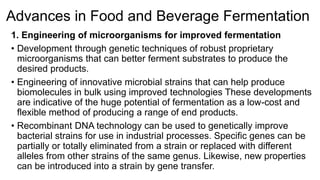Advancesin fermentstion
•Télécharger en tant que PPTX, PDF•
2 j'aime•552 vues
Genetic engineering techniques are being used to develop microbial strains that can more efficiently ferment substrates to produce desired products through fermentation. Specific genes can be inserted, deleted or replaced to give microbes new properties or abilities. For example, lactic acid bacteria have been engineered to contain only one type of lactic acid dehydrogenase, allowing the pure production of either L-lactic acid or D-lactic acid. New fermentation technologies and bioreactor designs are also being developed to improve process efficiency and product quality and yields.
Signaler
Partager
Signaler
Partager

Recommandé
Recommandé
Contenu connexe
Tendances
Tendances (20)
Scope of Industrial Microbiology and Biotechnology

Scope of Industrial Microbiology and Biotechnology
Similaire à Advancesin fermentstion
Similaire à Advancesin fermentstion (20)
Fermentative metabolism and development of bioprocessing technology, processi...

Fermentative metabolism and development of bioprocessing technology, processi...
Antimicrobial metabolites of lactic acid bacteria and its application

Antimicrobial metabolites of lactic acid bacteria and its application
Module-1_Introduction & Growth Curve – The Basics.pdf

Module-1_Introduction & Growth Curve – The Basics.pdf
Plus de foodfermentation
Plus de foodfermentation (7)
Advancesin fermentstion
- 1. Advances in Food and Beverage Fermentation 1. Engineering of microorganisms for improved fermentation • Development through genetic techniques of robust proprietary microorganisms that can better ferment substrates to produce the desired products. • Engineering of innovative microbial strains that can help produce biomolecules in bulk using improved technologies These developments are indicative of the huge potential of fermentation as a low-cost and flexible method of producing a range of end products. • Recombinant DNA technology can be used to genetically improve bacterial strains for use in industrial processes. Specific genes can be partially or totally eliminated from a strain or replaced with different alleles from other strains of the same genus. Likewise, new properties can be introduced into a strain by gene transfer.
- 2. Advances in Food and Beverage Fermentation 2. Metabolic pathway engineering of various enzymes Lactic acid production is dependent on lactate dehydrogenase (LDH) activities present in lactic acid bacateria. The lactic acid stereoisomerism is, in general, controlled by the enzymatic activity of LDH-L or LDH-D, although, in some cases, lactate racemases have been detected. Hence, lactic acid bacteria that contain only one of these LDH enzymes may produce a pure enantiomer. Lactobacillus helveticus has been the first lactic acid bacterium to be used and combined with LDH-D inactivation, a derivative developed that was able to produce pure L-lactic acid. By using a similar approach, pure enantiomers of lactic acid have also been obtained by the inactivation of specific LDH in other lactic acid bacteria.
- 3. Advances in Food and Beverage Fermentation 3. Improvement of the rheological properties of fermentation broths. 4. Development of more efficient process-driven technologies Examples: solid-state fermentation, consolidated bioprocessing, ultrasonication, syngas fermentation, and dark fermentation 5. New bioreactor designs Examples: High-mass transfer chemical reactors for methanotroph fermentation and versatile tray-type solid-state fermentation bioreactors